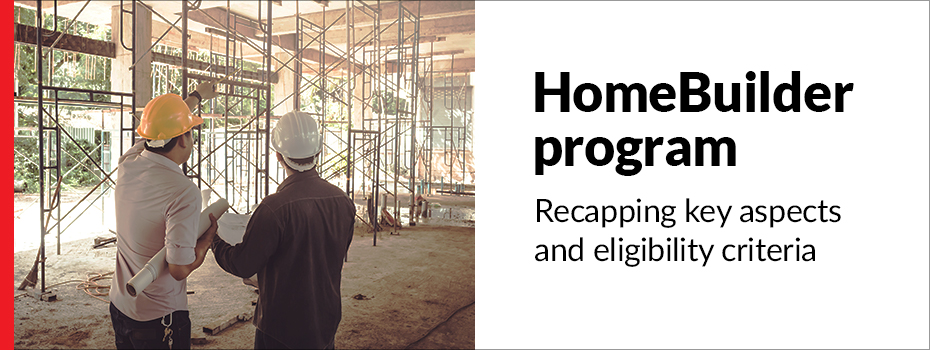
The HomeBuilder program – a recap
18 November 2021 18:09
Writer: John Darmanin, Practical Guidance Senior Legal Writer – Property module
The COVID-19 pandemic is affecting economies all over the world and GDP growth among OECD countries slowed to 0.7% in the fourth quarter of 2020. In that time, the Group of Seven economies (Japan, Canada, the United Sates, the United Kingdom, Germany, Italy and France) experienced GDP growth of only 0.8% and in an even worse result, GDP contracted by 0.4% in the euro area and the European Union.
The economic picture has been very different in Australia, however, with GDP rising by 3.1% over the same period.
Australia’s promising economic recovery has been built largely on the back of low community transmission of the virus and a generous suite of financial stimulus packages at both Commonwealth and state and territory levels.
One of the key pillars of the federal government’s economic response to the pandemic has been its HomeBuilder program, which has been extended so that it applies to build contracts entered into by 31 March 2021. With a late flurry of applications expected in the final weeks of the program, now is the perfect time for a recap of the key aspects of the program and the eligibility criteria.
For further information about the program, see the Latest Legal Updates on 22 June 2020, 7 August 2020 and 30 November 2020 by our expert property lawyers in the LexisNexis Practical Guidance Legal Writer team.
Background to the HomeBuilder program
Under the HomeBuilder program, a grant is available to eligible owner-occupiers (including first home buyers) wanting to purchase or build a new home, or substantially renovate an existing home. The grant, which is administered and distributed by state and territory revenue offices, is $25,000 for eligible contracts entered between 4 June 2020 and 31 December 2020 and $15,000 for eligible contracts entered into between 1 January 2021 and 31 March 2021.
As is the case with the state and territory First Home Owner Grants, the HomeBuilder grant is not taxed in the hands of the owner occupier(s) receiving the grant.
Eligible contracts
The HomeBuilder grant is available in relation to:
- a 'new build' contact, being a comprehensive building contract to build a new home or a contract to purchase an off-the-plan home or new home; or
- a ‘renovation contract’, being a contract with a registered builder to substantially renovate an existing home.
Eligibility criteria
To qualify for either the $25,000 or $15,000 grant, a person must be:
- a natural person (not a company or trust);
- the person named on the certificate of title to the property;
- an Australian citizen (permanent residents are not eligible for either grant);
- at least 18 years of age; and
- an owner-occupier.
The main remaining eligibility criteria are summarised in the following table. However, prospective applicants should review the full eligibility criteria on the relevant state or territory revenue office website prior to commencing the application process.
Date of eligible contract | 4 June 2020 to 31 December 2020 (inclusive) | 1 January 2021 to 31 March 2021 (inclusive) |
Amount of grant | $25,000 | $15,000 |
Due date for application to be submitted | 14 April 2021 (inclusive) | 14 April 2021 (inclusive) |
Construction commencement timeframe | Within 6 months after the date on which the eligible contract is signed | Within 6 months after the date on which the eligible contract is signed |
Price cap for a new build | $750,000 | New South Wales - $950,000 |
Victoria - $850,000 | ||
Other states and territories - $750,000 | ||
Price cap for a substantial renovation | Renovation contract value - Between $150,000 and $750,000 | Renovation contract value - Between $150,000 and $750,000 |
Home value - $1.5 million (pre-renovation) | Home value - $1.5 million (pre-renovation) | |
Income threshold (based on 2018-19 or 2019-20 taxable income) | Individual - $125,000 | Individual - $125,000 |
| Couple - $200,000 | Couple - $200,000 |
The construction work must be undertaken by a registered or licensed building contractor and is not available to owner-builders.
For an eligible contract entered into before 29 November 2020, the registered builder must have had a valid licence or registration before 4 June 2020. For an eligible contract entered into from 29 November 2020, the builder must have had a valid licence or registration before 29 November 2020.
Substantial renovations
To be a “substantial renovation”, a renovation must substantially alter the existing dwelling and should improve the accessibility, safety, or liveability of the property. The renovation cannot involve standalone structures that are detached from the main dwelling (e.g. the construction of a granny flat) or works that are primarily cosmetic in nature (e.g. landscaping). There is no strict requirement for renovation works to involve the removal or replacement of external walls, foundations, interior supporting walls, floors, the roof or staircases.
Impact of the HomeBuilder program
Initial government projections were that the program, which is uncapped, would have a total cost of approximately $680 million. However, based on preliminary application data reported by the states and territories, the total cost of the program is now likely to significantly exceed this. In addition, the pipeline of construction projects created by the program will continue to stimulate the residential building market for months or even years after the program ends.
The clock is ticking for Australians to take advantage of the HomeBuilder program and many other stimulus packages and protections introduced in response to the COVID-19 pandemic. For a summary of the various introduced measures, see our COVID-19: Property toolkit on the Property module of Practical Guidance, which is constantly being updated as changes are made.
For more information about how our expert Legal Writers can assist you and your clients with property law matters generally, contact your Relationship Manager or visit the Property module homepage on our Practical Guidance website.
Source: OECD, Australian Bureau of Statistics, Treasury
Contact our Experts Now

 LexisNexis
LexisNexis